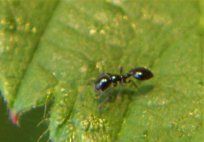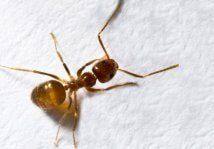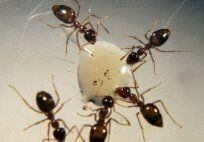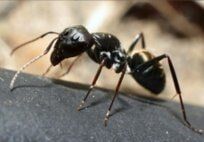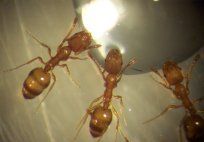ANTS
Acrobat Ants
Acrobat ants get their common name from their ability to acrobatically raise their abdomen over their thorax and head, especially when disturbed.
Color: Light brown to black, sometimes multicolored
Legs: 6
Shape: Long, segmented; heart-shaped abdomen
Size: 1/16 – 1/8” (2.5 – 4 mm)
Antennae: Yes
Carpenter Ants
Carpenter ants get their name because they excavate wood in order to build their nests. Their excavation results in smooth tunnels inside the wood. These are large ants ranging in size from one-quarter inch for a worker ant to up to three-quarters inch for a queen.
Color: Usually red, black or a combination
Legs: 6
Shape: Segmented; oval
Size: 5/8"
Antennae: Yes
Crazy Ants
Crazy ants get their common name from the workers' habit of running in an erratic, jerky manner when searching for food.
Color: Dark brown to black with gray sheen
Legs: 6
Shape: Long, segmented
Size: 1/16 – 1/8” (2.2 – 3.0 mm)
Antennae: Yes
Odorous House Ants
The odorous house ant gets its name from 25the strong, rotten coconut-like smell it gives off when crushed. These tiny brown ants range in size from one-sixteenth of an inch to one-eighth of an inch long.
Color: Brown or black
Legs: 6
Shape: Segmented; oval
Size: 1/16" - 1/8"
Antennae: Yes
Pavement Ants
25 Pavement ants get their name because they make their nests in or under cracks in pavement. These dark brown to black ants can also infest structures.
Color: Dark brown to blackish
Legs: 6
Shape: Segmented; oval
Size: 1/8"
Antennae: Yes
Pharaoh Ants
Pharaoh ants get their name from the mistaken belief that they were one of the plagues of Egypt during the time of Pharaohs. This species is thought to be native to Africa, but is currently found throughout the Unites States.
Color: Body usually pale, varying from yellowish to reddish with abdomen often darker to black
Legs: 6
Shape: Monomorphic with segmented body
Size: 1/16” (1.5 – 2.0 mm)
Antennae: Yes
- Mon - Fri
- -
- Saturday
- -
- Sunday
- Closed









